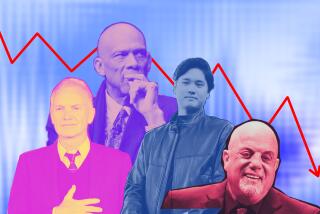Column: The burning mystery at the heart of the Wells Fargo scandal: Why does its CEO still have a job?
The outrageous scandal at Wells Fargo & Co., for which federal and local regulators hammered the bank for $185 million in fines and penalties earlier this month, speaks volumes about the decline of morality in corporate America. But the settlement leaves one burning question unanswered: Why does John G. Stumpf, the company’s chairman and CEO, still have a job?
The settlement announced Sept. 8 by the Consumer Financial Protection Bureau, the Office of the Comptroller of the Currency, and Los Angeles City Atty. Mike Feuer, followed a 2013 expose by my former Times colleague E. Scott Reckard. The $100 million to be paid to the CFPB is the largest fine it has extracted in its five years of existence.
The settlement stemmed from a scheme in which Wells Fargo bankers opened as many as 2 million fake accounts in the names of existing retail customers or nonexistent persons in efforts to meet unrealistic sales goals imposed from above. The bank says it fired 5,300 employees from 2011 through 2015, but it refuses to say how high up the discipline went. Plainly, most of the firings took place among the rank and file.
There was no incentive to do bad things.
— Wells Fargo CEO John G. Stumpf
Wells Fargo entered into the settlement without admitting or denying the underlying facts.
Yet there is no model of corporate management in which Stumpf can’t be considered responsible for what Sen. Elizabeth Warren, D-Mass., labeled the “staggering fraud” underlying the settlement, or for the devastating blow to his company’s reputation. Carrie Tolstedt, the executive who led the division where the fakery occurred, reported directly to him. So he either knew about it, in which case he is complicit, or he didn’t know, which would demonstrate his inability to get his hands around activities at his own company. It’s hard to say which interpretation makes him look worse. Either way, he should have been cast out as part of the settlement — and the Wells Fargo board of directors should have followed him down the oubliette. (We’ll get to them in a moment.)
Stumpf is certain to take some lumps when he appears Tuesday before the Senate Banking Committee. But such public flayings really have only two purposes. For senators, they’re an opportunity for bombast and breast-beating about bad corporate behavior; typically, the louder the bombast, the lower the chances it will produce new laws or necessary tightening of regulations.
The only member likely to draw real blood is Warren, who demanded that Stumpf be haled before the committee and already has asked Wells Fargo to explain why $20 million in annual bonuses and as much as $125 million in retirement benefits shouldn’t be clawed back from Tolstedt.
For Stumpf, Tuesday’s hearing will be an opportunity to expand on the defense he already has offered in interviews: that the scam was the work of a few thousand lower level “rogue” employees misinterpreting their marching orders.
“There was no incentive to do bad things,” Stumpf told the Wall Street Journal. This is, of course, a lie; the evidence shows that relentless sales targets left employees with little alternative while managers cracked the whip. As the lawsuit filed by Feuer alleged, “unrealistic sales quotas” drove Wells Fargo’s bankers to “engage in fraudulent behavior to meet those unreachable goals.”
Stumpf also said, “The 1% that did it wrong, who we fired, terminated, in no way reflects our culture...That’s a false narrative.”
This also is a lie. The bank says it fired 5,300 employees out of its total workforce of 270,000. That’s about 2%, not 1%. Stumpf’s inability or unwillingness to get his figures straight doesn’t inspire much confidence in his grasp of his own company.
Warren wondered, “How is it possible that more than 5,000 employees could bilk customers over the course of five years?” How could such a practice, extending coast to coast, take place without it reflecting the company’s culture? Plainly, it defined Wells Fargo’s culture.
Stumpf told the Journal, “I feel accountable and our leadership team feels accountable — and we want all our stakeholders to know that.” What does accountability mean in this context? If he doesn’t step down or get removed, this is merely a vacuous recital of the CEO’s nirvana: accountability without consequences.
The implicit defense raised by Stumpf’s defenders is that the consumer ripoff at the center of the scandal was, in context, trivial — look at how much Wells Fargo has grown under this management. But that’s a reductionist argument. One reason that the scandal looks trivial is that no major executive has been disciplined; so how big could it be? This only underscores the downside of letting executives off scot-free — it makes major failings look minor. The answer is to start threatening the bosses with losing their jobs, or going to jail, and they’ll start to take things seriously.
Indeed, the bank is doing its best to make the scam look trivial. It says it already has paid out $2.6 million in refunds to 100,000 customers. That’s an average of $26 each. Let’s ask: If you were the victim of identity theft by your own bank, would you consider $26 to be adequate compensation?
Stumpf’s defenders will say that firing him would have little more than a symbolic effect. Yet much of a CEO’s role is symbolic — and Stumpf played the role to a T. Silver-haired and polished to a high gloss, he looked the very model of a modern major banker. As one bank analyst described him after the settlement, “he’s like Americana in the form of a large bank CEO.”
But symbolism cuts both ways, positively and negatively. Stumpf’s management, or lack of it, gives the lie to Wells Fargo’s facile “vision and values” statement, which states (next to a photo of Stumpf that could have been taken directly from a Brooks Bros. catalog page), “Everything we do is built on trust….It’s earned relationship by relationship.” No one takes such blather seriously, but seldom is it undermined as vividly by corporate behavior as it is at Wells Fargo.
In any event, more than symbolism is at issue. Wells Fargo’s share price fell by as much as 10% after the settlement; as of Monday, it’s still down 8%. That’s a cost to shareholders. The $185-million settlement will also come out of their pockets, not senior executives’. The questions sure to be raised by regulators about whether Wells Fargo has become too big to manage will be a further threat, as will the prospect of further civil actions or even criminal prosecution.
Warren’s question about clawing back Tolstedt’s pay is apt, but it doesn’t go far enough. The clawback provision appearing in the company’s proxy statement applies to “improper or grossly negligent failure, including in a supervisory capacity, to identify, escalate, monitor or manage… risks material to the Company.” How could that not apply to the chairman and CEO on whose watch the very reputation of the company was shattered, opening it up to perhaps billions of dollars in civil judgments and redoubled scrutiny by banking regulators? Stumpf received more than $100 million in compensation in 2011-15, which would make for a good start in covering the company’s penalties.
That brings us to the other players in this tragic drama: the Wells Fargo Board of Directors. The firm’s proxy statement brims with testimonials to how the directors’ “leadership and management experience” enhances Wells’ performance. But the only skill they really seem to exhibit is the ability (to quote George Orwell) to hold onto their board seats as if with “prehensile bottoms.”
Some have served since the 1990s, and one for nearly a quarter-century. That suggests that cobwebs have been growing in the board suite for years. The board cost Wells Fargo $20.8 million in compensation during the five years of scandal, each member collecting an average of nearly $300,000 a year. What Wells Fargo’s shareholders got for this money was scandal and a $185-million bill.
Investors might be well-advised to steer clear of other public companies on which these directors serve, lest their lack of oversight extend beyond Wells Fargo. Investors in McDonald’s and Chevron might want to pay special attention, as they are served by two Wells Fargo directors each. Stumpf himself serves on the boards of Chevron and Target; perhaps that helps explain why he didn’t have enough time to keep an adequate eye on his own company.
As a public service, here’s a list of the directors, including their date of initial appointment and other board memberships where applicable.
--John D. Baker II, business executive (director since 2009); director of FRP Holdings.
--Elaine L. Chao, former secretary of Labor (2011): Ingersoll-Rand, News Corp., Vulcan Materials.
--John S. Chen, technology executive (2006): BlackBerry Ltd. (also CEO), Walt Disney Co.
--Lloyd H. Dean, CEO of Dignity Health (2005): McDonald’s, Navigant Consulting.
--Elizabeth A. Duke, banking executive and ex-Fed governor (January 2015).
--Susan E. Engel, consumer products executive (1998).
--Enrique Hernandez Jr., business executive (2003): Chevron, McDonald’s, Nordstrom.
--Donald M. James, retired executive (2009): Southern Co.
--Cynthia H. Milligan, business school dean, University of Nebraska-Lincoln (1992): Kellogg Co., Raven Industries.
--Federico F. Pena, former secretary of Transportation (2011): Sonic Corp.
--James H. Quigley, former CEO, Deloitte LLP (2013): Hess Corp., Merrimack Pharmaceuticals.
--Stephen W. Sanger, former CEO, General Mills (2003): Pfizer Inc.
--Susan G. Swenson, CEO, Novatel (1998): Harmonic Inc., Novatel Wireless.
--Suzanne M. Vautrinot, cyber security expert (February 2015): Ecolab Inc., Symantec Corp.
Keep up to date with Michael Hiltzik. Follow @hiltzikm on Twitter, see his Facebook page, or email [email protected].
Return to Michael Hiltzik’s blog.
UPDATES:
11:35 a.m.: This post has been updated to reflect that Wells Fargo did not admit or deny the allegations underlying the settlement.
More to Read
Inside the business of entertainment
The Wide Shot brings you news, analysis and insights on everything from streaming wars to production — and what it all means for the future.
You may occasionally receive promotional content from the Los Angeles Times.











